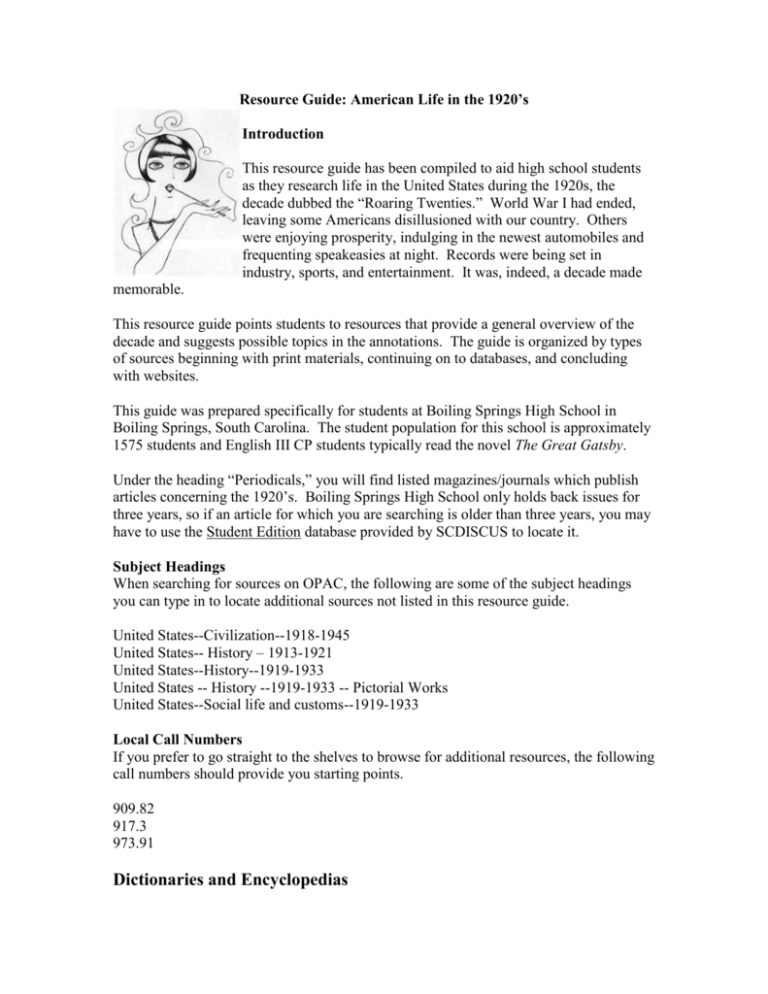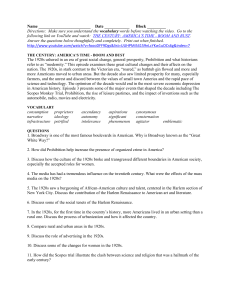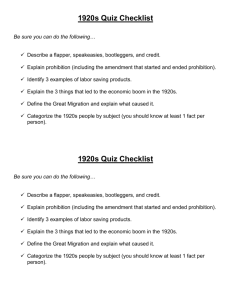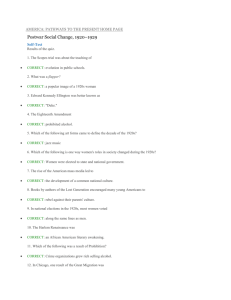Resource Guide: American Life in the 1920`s - bulldogden
advertisement

Resource Guide: American Life in the 1920’s Introduction This resource guide has been compiled to aid high school students as they research life in the United States during the 1920s, the decade dubbed the “Roaring Twenties.” World War I had ended, leaving some Americans disillusioned with our country. Others were enjoying prosperity, indulging in the newest automobiles and frequenting speakeasies at night. Records were being set in industry, sports, and entertainment. It was, indeed, a decade made memorable. This resource guide points students to resources that provide a general overview of the decade and suggests possible topics in the annotations. The guide is organized by types of sources beginning with print materials, continuing on to databases, and concluding with websites. This guide was prepared specifically for students at Boiling Springs High School in Boiling Springs, South Carolina. The student population for this school is approximately 1575 students and English III CP students typically read the novel The Great Gatsby. Under the heading “Periodicals,” you will find listed magazines/journals which publish articles concerning the 1920’s. Boiling Springs High School only holds back issues for three years, so if an article for which you are searching is older than three years, you may have to use the Student Edition database provided by SCDISCUS to locate it. Subject Headings When searching for sources on OPAC, the following are some of the subject headings you can type in to locate additional sources not listed in this resource guide. United States--Civilization--1918-1945 United States-- History – 1913-1921 United States--History--1919-1933 United States -- History --1919-1933 -- Pictorial Works United States--Social life and customs--1919-1933 Local Call Numbers If you prefer to go straight to the shelves to browse for additional resources, the following call numbers should provide you starting points. 909.82 917.3 973.91 Dictionaries and Encyclopedias These sources are your best starting point. A general source such as The World Book Encyclopedia provides you with an overview of the decade. Because subject specific dictionaries and encyclopedias often go into more depth on topics, they can provide help to the researcher who has yet to narrow down his/her topic. Once your topic has been narrowed, use the index of these subject specific sources to discover more information. Reminder: All sources with REF in the call number can only be checked out on an overnight basis. General REF 031 WOR Handlin, Oscar. "United States, History of the: 1917-1929." The World Book Encyclopedia. 2006. 184-187. This article provides an excellent overview of the 1920s. The two subdivisions dealing with the 1920s are entitled “Life during the Roaring Twenties” and “The economy – boom or bust.” Topics covered include modern life (radio broadcasting, most of the population living in urban areas, the automobile, and the motion picture industry), changes and problems (rise in juvenile delinquency and crime, weakened family ties, Prohibition, revivalism, Teapot Dome Scandal, Ku Klux Klan), youth (flappers and their styles, speakeasies), heroes (Charles Lindbergh, Babe Ruth, Red Grange, Jack Dempsey), the economy (manufacturing boom, worsened finances of farmers and laborers, stock market crash), and technology (electric washing machines, refrigerators, automobiles). A “Period facts in brief” textbox provides a quick look at the Presidents, important dates, and population facts. Several black and white photos support the text. Subject Specific REF 973.03 DIC Ketz, Lousie Bilebof. Dictionary of American History. New York: Charles Scribner’s Sons, 1976. This seven volume set also includes a separate index volume to aid in quickly locating topics. Alphabetically arranged, this source is a compilation of information about thousands of separate facts on American history. Written by scholars, the entries are excellent starting points in researching various topics. Some entries related to the 1920s include “Bootlegging,” “Harlem,” “Jazz,” “Radio,” “Scopes Trial,” “Motion Pictures,” “Aviation – Lindbergh’s Atlantic Flight,” and “TeaPot Dome Oil Scandal.” Other topics are touched upon in larger entries, such as “flappers” which is discussed briefly in “Dress.” REF 973.03 ENC Vol. 7 and Vol. 8 Nash, Gary B., ed. Encyclopedia of American History. New York: Facts on File, 2003. Volumes 7 ( The Emergence of Modern America 1900 to 1928) and 8 (The Great Depression and World War II 1929-1945) provide alphabetically arranged entries of many of the most important people, events, and topics of American life in the 1920s. Also included in each volume are a chronology of events, important documents, and a bibliography related to the era covered. Each volume also contains an alphabetical index. Some entries related to the 1920s include “Ellington, Duke,” “Byrnes, James F.,” “Radio,” “Entertainment, popular,” “Education,” “Sacco and Vanzetti,” and “Population Trends.” REF 973.9 St. Pendergast, Tom, and Sara Pendergast, ed. St. James Encyclopedia of Popular Culture. Detroit: St. James Press, 2000. This five volume encyclopedia contains more than 2,500 signed entries that range in length from 75 to 3,000 words. Entries are alphabetically arranged by the name under which the topic is most commonly known, but in-text cross references are also provided to help aid the researcher. A section at the end of many of the entries provides titles for further reading. The final volume contains three indexes: a Time-Frame Index, a Category Index, and an Alphabetical Index. Some of the many topics that might be of interest to those researching American life in the 1920s include “Flagpole sitting,” “Flappers,” “Houdini, Harry,” “Capone, Al,” “Popsicles,” and “Tabloids.” (This source is also an e-book that is part of the History Resource Center available through SCDISCUS.) Reference Sources These sources also provide excellent information, each with a different focus. You can feel confident in the authority of sources such as these. REF 900 SCH Daniel, Clifton, ed. “1920 – 1929.” 20th Century Day by Day. New York: DK Publishing, Inc., 1999. 260-377. This source is organized chronologically and typically provides a one page spread of each month of the decade. Each month features a textbox that provides a monthly calendar and then lists prominent events, births, and deaths for the month. Several important events for the month are then summarized and presented newspaper article style. A massive index permits searching by topic, providing the month(s) and year(s) where information can be located. REF 909.82 DER Derks, Scott, ed. "1920-1939 Return to Normalcy, the Great Depression, and Recovery." The Value of a Dollar Prices and Incomes in the United States 1860 - 1999. 2nd ed. Millerton, NY: Grey House Publishing, 1999. 134-81. This article provides an economic overview of the era, dividing it into two distinct halves: Return to Normalcy (1920-1929) and the Great Depression and Recovery (1930- 1939). Each of these two divisions is then further subdivided into the two halves of each decade. These provide a Historical Snapshot and general average costs and incomes. The strength of this source then follows: a detailed list of specific prices for consumer goods ranging from Bayer Aspirin to a Chrysler Six Phaeton. REF 973.03 WEB Van Doren, Charles Lincoln. Webster’s Guide to American History: a Chronological, Geographical, and Biographical Survey and Compendium. Springfield, MA: G. & C. Merriam Company, 1971. Although the copyright date is extremely dated, the material included suits the purpose of this resource guide. This source includes a chronology of the decade (pages 407 – 434). A look at the Density of Population maps of 1880 and 1930 provides a clear illustration of the trend of moving to urban areas (pages 708709). The Additional Information section includes the results of the 1920, 1924, and 1928 Presidential elections, both electoral and popular votes (p. 769). Also included in this section is a list of popular songs by years (p. 781), popular books by years (p. 789), and Academy Award Winners (p. 791). The final section of the source includes brief biographical sketches of not only the Presidents of the 1920s, but also several other notables including F. Scott Fitzgerald, Harry Houdini, William Jennings Bryan, Babe Ruth, and Will Rogers. REF 973.91 UXL Pendergast, Tom and Sara Pendergast. UXL American Decades 1920-1929. Detroit: Thomson Gale, 2003. Volume 3 of UXL American Decades focuses on the decade of the 1920s. There is a general overview of the decade and then each of the eight chapters focuses on one of the following topics: Arts and Entertainment, Business and the Economy, Education, Government/Politics and Law, Lifestyles and Social Trends, Medicine and Health, Science and Technology, or Sports. The book’s organization simplifies searches by not only providing a thorough Table of Contents and Index, but also by the repetition of 5 subdivisions in each chapter: Chronology, Overview, Headline Makers, Topics in the News, and For More Information. An excellent source for concentrated information on your chosen topic. Books Books can be general or subject specific, depending upon the author’s intent. The books chosen for this section were chosen because each offered more depth on an aspect of the era than the reference works above. 973.91 HAN Hanson, Erica. The 1920s. San Diego: Lucent Books, 1999. This book, divided into seven chapters, provides insight into the daily lives of Americans in the 1920s. Besides covering topics that seem to be common to most books about the decade (the economy, prohibition, transportation, and entertainment), this book distinguishes itself from the others listed in this resource guide by providing a full chapter on intolerance. Included in the back matter of the book are a chronology, bibliography, and index. 973.91 JAZ Britten, Loretta and Paul Mathless, ed. Our American Century The Jazz Age: The 20s. Vol. 3. New York: Time Life Incorporated, 1998. 10 vols. This volume from Our American Century provides an overview of the era in the first chapter “The Quest for Normalcy” and then focuses on nine other topics: “Flaming Youth,” “Flight,” “All that Jazz,” “Boom and Bust,” ‘The Sports Stars,” “Prohibition,” “A Lively Press,” “Notables,” and “Fads and Ballyhoo.” Each chapter is filled with full page black and white photographs from the 1920s, giving the reader an intense view into the decade. Also included are artifacts (Pennsylvania Railroad train schedule, tickets to Bessie Smith and Duke Ellington concerts, tabloid articles on various subjects such as the Leopold-Loeb case, and a prescription form for medical liquor to name a few). 973.91 MCC McCutcheon, Marc. The Writer’s Guide to Everyday Life from Prohibition through World War II. Cincinnati: Writer’s Digest Books, 1995. This book, divided into eight chapters, provides insights into daily American life in the 1920s. Chapters such as “Slang, Colloquialisms, and Everyday Speech,” “Prohibition,” “Crime,” “Transportation,” “Radio and Radio Shows,” and “Music and Dance” provide details not found in general reference works. Also included in the back are four chronologies: History Events, Innovations, and Fads; Hit Songs; Books; and Movies. These will give the researcher a quick overview of daily life in each year. The only drawback to this worthy book is that it has no index to guide the researcher; he/she should depend on the chronologies and the Table of Contents to help locate specific information. Biographical Sources Biographical sources provide insight into the lives of notable people. The sources listed below provide varying degrees of information. BSHS library also has individual biographies on many notable people from the 1920s that you may wish to consult. REF 920.073 DAB Wagley, Stephen, ed. Dictionary of American Biography. New York: Charles Scribner’s Sons, 1996. Don’t be mislead by the title of this work; it is a comprehensive coverage of notable Americans contained in 10 volumes. In addition to those ten volumes, BSHS also has 10 supplements and a cumulative index. The index has six main subdivisions, but the one the subdivision most useful to you will be the subject index. Here you will find an alphabetical list of all the persons about whom articles have been written. The index lists the birth and death dates of the subject and then directions you to the volume and page number where you will locate the biography. Biography Resource Center. 2007. Gale. SCDISCUS. 2 Dec. 2007. <http://www.scdiscus.org> This database indexes 135 reference sources and thousands of periodicals. There are three types of searches you can execute: Advanced, Basic (by name only), or Biographical Facts Search. You can also choose to browse by category. Results are provided on a tabbed page. The four tabs are Biographies, Brief Biographies, Magazine Articles, and Websites. Biography.com. 2007. A&E Television Networks. 2 Dec. 2007 <http://www.biography.com/>. This site offers multimedia sources to enhance your knowledge about notable people in the 1920s. On the home page, use the search box to execute a basic search using a person’s name as the search term. Use the link to the site map to discover that you can also search for notable people in categories. Photo galleries and videos are also available, including a photo gallery on Harry Houdini, and videos on Al Capone, Bette Davis, Agatha Christie’s mysterious disappearance for 10 days in 1926, and Prohibition and speakeasies. Periodicals Journals and magazines provide further information on this topic. Many articles published in the journals listed below offer new perspectives on the era, giving the researcher ideas on how to “make the old new.” BSHS Media Center only subscribes to one print journal related to the topic, but one other that can be accessed through SCDISCUS is starred below. American History published by Weider History Group focusing on U.S. history. *American Heritage published by American Heritage, a division of Forbes, Inc. focusing on North American studies and U.S. History. Can be accessed through the Student Edition database listed in the next section. Databases from SCDISCUS Provided to all citizens in the state of South Carolina by our state legislature, SCDISCUS provides a wealth of information you can access from home or school. (If accessing from home, you will need to ask your media specialist for a username and password.) Options to simplify research include research guides, search tips, and the ability to email articles directly to yourself. You can also choose to print an article without having to copy and paste it into another document. Source citations are provided for each of the documents, making it easy to add to a Works Cited or Bibliography page for your project. Gale Virtual Reference Library. 2007. Gale Cengage Learning. SCDISCUS, 2 Dec. 2007. <http://www.scdiscus.org> This database indexes e-books provided by Thomson Gale. You may choose to execute a basic or advanced search that will comb through all of the e-books, or you can choose to use just one particular e-book by clicking on the subject category under the heading “Or select a publication below” and choosing from the e-books listed. Once your search results are displayed, you can choose to use the “Narrow Results” option that appears in a sidebar, helping you to further pinpoint the information you desire. E-books that are particularly useful for this resource guide include Gale Encyclopedia of U.S. Economic History; St. James Encyclopedia of Popular Culture; Fashion, Costume, and Culture: Clothing, Headwear, Body Decorations, and Footwear through the Ages; and International Dictionary of Films and Filmmakers. Some possible search terms: 23 Skidoo Speakeasy Prohibition Capone, Al Radio History Resource Center. 2007. Thomson Gale. SCDISCUS. 2 Dec. 2007. <http://www.scdiscus.org> This database is designed to be your “one stop shopping” destination for anything history. It indexes thousands of documents from reference sources, over 5,000 primary documents, and “nearly 200 scholarly full-text journals.” You can execute several types of searches: Basic, Person, Subject, or Advanced. Results are provided on a tabbed page. The four tabs are Reference Materials, Periodicals, Primary Sources, and Maps and Multimedia. Related results are listed in a sidebar. Another feature of this database is a timeline. Click on “Chronology” on the home page to go to the timeline. Roll your cursor over the timeline to choose an era and History Resource Center will then provide a sampling of articles representing that era. Choose “Jazz Age 1920-1929” for articles to help you with your research on American life in the 1920s. If you wish to use search terms, below are some suggestions: United States History 1921-1945 Jazz Age Flappers 1920s (Decade) Fads & 1920s Smith, Bessie Student Edition. 2007. Gale. SCDISCUS. 2 Dec. 2007. <http://www.scdiscus.org> This database indexes articles from over 400 periodicals, focusing on topics that high school students often research. Results are provided on a tabbed page. The five tabs are labeled Magazines, Academic Journals, Books, News, and Multimedia. You can narrow your results by using the “search within these results” feature on a sidebar or by clicking on the hyperlinks in the “narrow results” list provided on some searches. Some suggested search terms: Dance marathons Ku Klux Klan Gatsby Vanzetti St. Valentine’s Day Massacre Internet Multimedia Sources The websites in this section have been carefully screened to assure that they are created by authoritative sources. All were chosen because the multimedia information they provide assists researchers in obtaining a well-rounded view of the decade. "1900-1929." American Memory. 31 Oct. 2007. Library of Congress. 2 Dec. 2007 <http://memory.loc.gov/ammem/browse/ListSome.php?timePeriod=1900-1929>. The American Memory Project by the Library of Congress is a digital record of American history. It provides access to sound recordings, manuscripts, photographs, moving images, sheet music, and maps. The 1900-1929 page contains links to 77 collections including advertising, baseball cards, portraits of Presidents and First Ladies, and Woman Suffrage books and pamphlets. You will find these useful in creating projects concerning life in America in the 1920s. A basic search box at the top of the page allows you to search the collections for specific topics. You might try the search terms “Flappers,” Al Capone,” “Radio Shows,” and “Film.” Digital History. Ed. Steven Mintz. 2007. University of Houston. 2 Dec. 2007 <http://www.digitalhistory.uh.edu/>. This site offers a wealth of historical information. To fully appreciate all that is available, your first click should be on “Site Map.” This will give you an overview of the site and help you in focusing your search. Most useful to those researching American life in the 1920s will be “Historic Newspapers,” “Hollywood’s America,” “Science and Technology: Engines of our Ingenuity,” and “History Day by Day.” Sann, Paul. The Lawless Decade. Estate of Paul Sann. 3 Dec. 2007. <http://www.lawlessdecade.net/index-2.htm> This site is excerpted from The Lawless Decade: A Pictorial History of a Great American Transition From WW I Armistice and Prohibition to Repeal and the New Deal by Paul Sann published in 1957. The menu on the left sidebar offers links to each year of the decade. A secondary dropdown menu appears for each year offering links to several key events. Don’t be mislead by the title of the book upon which this site is based. The site offers much more than pictures. Clear explanations of each of the events accompany the photographs and the music embedded on each page helps to further immerse you in the era. Bibliography Bibliographies are excellent sources to find other materials available on a topic. BSHS does not have any bibliographies on American life in the 1920s, but you will usually find a bibliography at the end of a source, or separate bibliographies at the end of each chapter in a source. R 973.92 American 1920-1929 Baughman, Judith, ed. American Decades 1920-1929. New York: Gale Research Inc., 1996. This source has an extensive bibliography entitled “General References” on pages 487-500. It is subdivided into several categories: General, Arts, Business and the Economy, Education, Fashion, Government and Politics, Law, Lifestyles and Social Trends, Media, Medicine and Health, Religion, Science and Technology, and Sports. Although the bibliography is not annotated, a researcher can use the categories to narrow sources that might be helpful to him/her. In each category, the works are listed alphabetically according to author or editor names. (BSHS does not have this source, but it is available to students at the Spartanburg Public Library using the call number listed.) Flapper image on page 1 of resource guide is from “E Pluribus Unum: America in the 1920s.” Assumption College. Accessed 3 Dec. 2007. <http://www.assumption.edu/users/McClymer/his394/flapper2.jpg> DISCUS logo provided by <http://www.scdiscus.org/index.php?option=com_content&task=view&id=79&Itemid=100>








